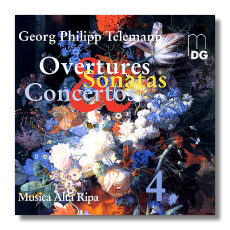
The Internet's Premier Classical Music Source
Related Links
- Telemann Reviews
- Latest Reviews
- More Reviews
-
By Composer
-
Collections
DVD & Blu-ray
Books
Concert Reviews
Articles/Interviews
Software
Audio
Search Amazon
Recommended Links
Site News
 CD Review
CD Review
Georg Philipp Telemann

Overtures, Sonatas & Concertos, Volume 4
- Concerto in G Major for 2 Violins, Viola & Continuo, TWV 43:G5
- Ouverture in E Major for Oboe d'amore, 2 Violins, Viola & Continuo, TWV 55:E2
- Concerto in B Flat Major for 2 Recorders, 2 Violins, Viola & Continuo, TWV52:B1
- Sonata in D Major for Violin & Continuo, TWV 41:D1
- Concerto in A minor for Recorder, Oboe, Violin & Continuo, TWV 43:a3
Musica Alta Ripa
Dabringhaus und Grimm MDG3091384-2 DDD 60:34
Also see: Volume 1 | Volume 2 | Volume 3
Each time that I pop a new Telemann disc into the CD player, I fall in love with his music all over again. No longer need we think of him as Bach's less interesting contemporary. Georg Philipp has delights all his own, and one of the joys of the present era is finding so many excellent musicians who seem to want nothing more than to play and record little-known music from the Baroque era.
This disc is Volume 4 in Musica Alta Ripa's series of Telemann's Concertos and Chamber Music. Although the disc nominally contains three concertos, one ouverture (another term for a suite), and a sonata, the formal differences among these five works are not nearly as pronounced as they might have been 50 or 100 years later. Just as Vivaldi sometimes used the terms "concerto" and "concerto grosso" interchangeably, one finds flute virtuoso Johann Joachim Quantz praising "a sonata with three concertante instruments" byTelemann. Perhaps he even was referring to the Concerto in A minor for recorder, oboe, violin, and basso continuo on this CD. Given the roles played by the three solo instruments, and their free, dynamic interactions with each other and with the rest of the ensemble, one might suggest that calling the work a concerto is a tentative compromise at best. A rose by any other name would smell as sweet?
Telemann was a more cosmopolitan composer than Bach. He traveled extensively, was interested in musical trends all over Europe, and he incorporated them into his music with great naturalness. One can hear not only the Germans Bach and Handel in his music, but also the influence of Italy, France, England (perhaps through his friendship with Handel) and even Eastern Europe. This CD displays Telemann's ability to soak up different musical styles like a sponge, and then to imprint them with his own musical personality. Nevertheless, each work on this CD has its own character; there's no danger of monotony here. I am delighted by the pomp (and perhaps a little comic pomposity!) of the Concerto in G for two violins, viola, and basso continuo; the easy grace and melodiousness of the Ouverture in E Major, and the light melancholy of the aforementioned Concerto in A minor. No matter what combination of instruments he is working with, Telemann finds interesting ways of combining them while remaining true to their individual characteristics.
Musica Alta Ripa is a period instrument ensemble that has been in existence since 1984. The booklet lists just ten players in this group, so it should not be a surprise that even the "concertos" have the transparency of chamber music. Each member is a virtuoso; hear, for example, violinist Ursula Bundies sail her way through the happy, mellow Sonata in D with serene confidence. Throughout this CD, there is wit and excitement, but Musica Alta Ripa never makes the mistake that some ensembles of this type make – the mistake of driving the music too hard. Telemann's versatility is allowed its fullest scope here, and the CD's playing time of an hour goes by in a blink. No matter; you'll play it again. I did… repeatedly. Fine engineering, too.
Copyright © 2006, Raymond Tuttle




















